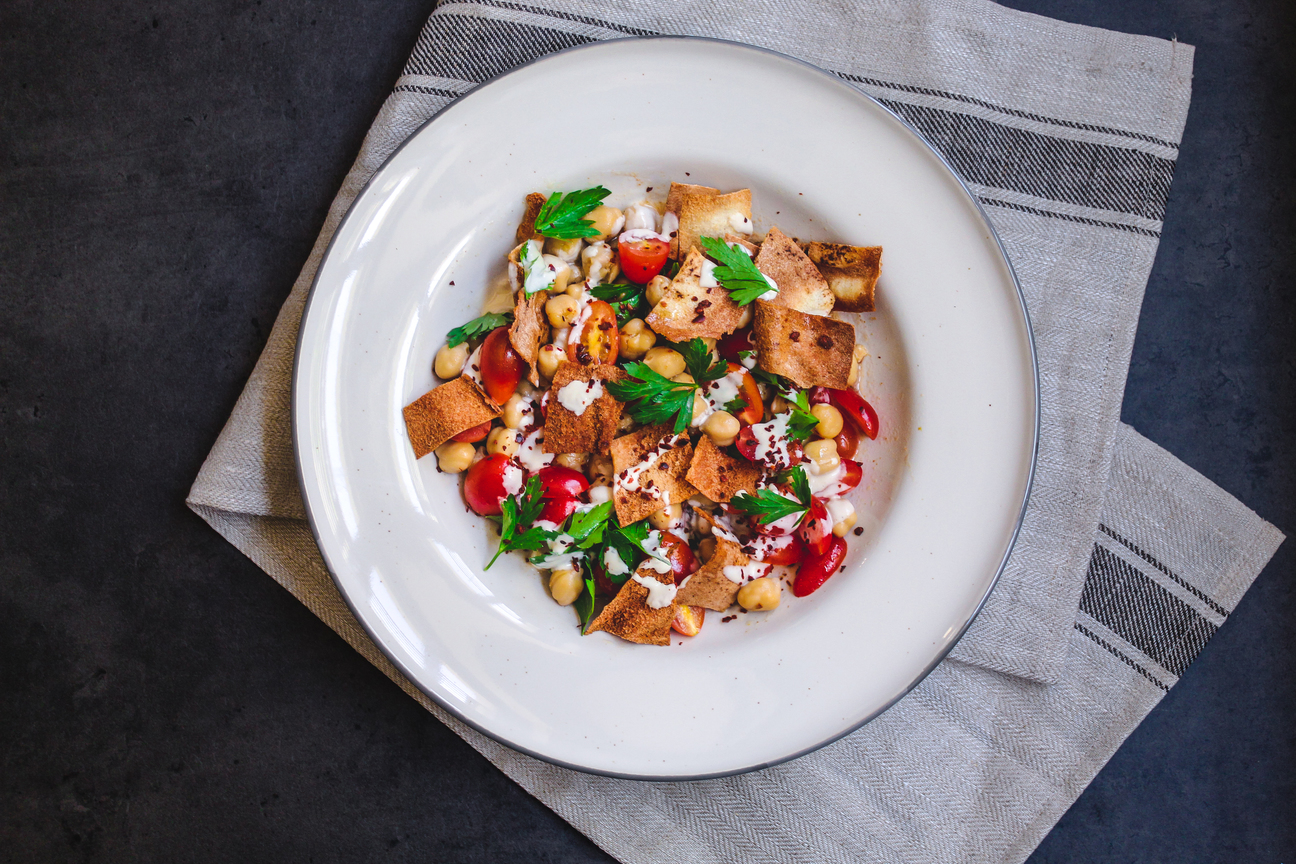When I was younger, I didn’t understand how lucky we were to come home to real food every single day—like this fatayer sabanekh recipe, a spinach-filled pastry we grew up eating for lunch, snacks, and gatherings. We didn’t eat out. We didn’t do takeout. Instead, my mom cooked, every day, no shortcuts. At the time, I was envious of friends who had fast food or restaurant outings. Now, I can’t stop thinking about how those everyday meals shaped my relationship with food, family, and memory.
Lunch, in our home, was sacred. It brought us together. And nothing brought us together like pastries.
Pastries were (and still are) my mom’s specialty. She’s so well known for them in our family that she’s lovingly called “em al-ajeen”—the mother of dough. She could tell if a dough was good by the sound it made when kneaded. She didn’t use measurements for years—she just knew when the flour-to-water ratio was right. And even now, her hands carry decades of practice, muscle memory, and love.
She taught us how to feel the dough between our fingers, to recognize elasticity, and to know when it needed more water or more rest. Watching her bake was like watching a language I hadn’t yet learned, but always understood.

Fatayer Sabanekh Recipe: A Staple with a Twist
Spinach pastries, or fatayer sabanekh, are one of the first pastries I fell in love with. Mama made them often—especially in early winter, when spinach was fresh and abundant. And yes, this was one of the very few ways she could convince me to eat greens.
Most people who’ve grown up in the region know spinach fatayer as a classic part of the mezze or bakery rotation—found in homes, school lunches, bakeries, and gatherings. The filling is usually lemony, slightly sour, and deeply savory, thanks to sumac, olive oil, and onion.
But here’s the thing that makes my mom’s version different:
🔹 She never squeezes the spinach dry.
🔹 She adds a generous amount of lemon and oil.
Most recipes go to great lengths to remove moisture, fearing soggy dough. But her method? Never soggy, and always better. The filling is bright, juicy, and full of flavor—and it somehow just works.
A Family Quirk: The Parsley Tahini Dip
This may sound strange, but in our family, we always serve spinach fatayer with a parsley tahini dip. I’ve never seen anyone else do this. It’s just our thing.
The creamy tahini brings richness, the parsley adds freshness, and together they balance the tang of the spinach perfectly. It might be an acquired taste, but once you try it, it’ll make perfect sense.

🔺 Shaping Spinach Fatayer
Fatayer come in many forms—folded squares, boats, half-moons—but in our home, spinach ones are always shaped as sealed triangles. It’s more than just tradition—it’s also functional. The triangular fold seals in the juicy filling without leaking. The triangular fold is the most common shape for this fatayer sabanekh recipe, helping seal in the juicy filling and hold up beautifully during baking.
Here are some shaping tips:
-
Keep your edges clean and dry—any moisture will keep the dough from sealing properly.
-
Pinch firmly along each edge to seal tight. If needed, use a fork to crimp.
-
Don’t overfill! The filling expands slightly during baking.
Once shaped, they puff slightly in the oven, holding their shape and crisping to golden perfection.
If you love stuffed pastries, don’t miss my cheese sambousek—another family favorite that freezes beautifully and can even be made with halloumi.
❄️ Freezer Tips
Spinach fatayer freeze beautifully—perfect for making ahead and baking fresh when needed.
To freeze unbaked fatayer:
-
Shape and place them in a single layer on a tray.
-
Freeze until solid, then transfer to a freezer-safe bag or container for up to 3 months.
When ready to bake:
-
-
Remove the desired amount from the freezer and place on a tray lined with parchment.
-
Cover with a clean kitchen towel and let thaw completely at room temperature.
-
Once thawed, let them proof for 30–45 minutes, until slightly puffy.
-
Bake as directed.
-
To freeze baked fatayer:
-
Let them cool completely.
-
Freeze in a single layer, then store in an airtight container.
-
Reheat in a preheated 180°C (350°F) oven until warmed through and crisp on the edges.
This fatayer sabanekh recipe also freezes beautifully, making it ideal for Ramadan prep, lunchboxes, or baking fresh in small batches.
Spinach Pastries
Ingredients
Dough
- 3 cups all-purpose flour
- ½ tbsp instant dry yeast
- 1 tsp salt
- 1 tsp sugar
- ¼ cup olive oil
- Water as needed (¾ – 1 cup)
Filling
- 400 g fresh spinach (leaves + tender stems), washed, dried & chopped
- ½ cup olive oil
- ⅓ cup lemon juice
- 1 tbsp sumac
- ½ tbsp spicy pepper paste (optional)
- 1 onion finely chopped and squeezed dry
- 1 ½ tsp salt (adjust to taste)
Instructions
- Make the dough: In a bowl, combine flour, yeast, sugar, and salt. Stir in olive oil and most of the water. Knead until soft and elastic (~10 minutes).
- Place dough in a lightly oiled bowl. Cover and let rise 45–60 minutes.
- Make the filling: In a large bowl, mix all filling ingredients. Taste and adjust seasoning.
- Preheat oven to 220°C (425°F). Grease 2 baking trays with olive oil.
- Divide dough into 18–21 balls. Cover with a kitchen towel while shaping.
- Roll each ball into a ½ cm thick circle. Add filling to center, leaving edges clean.
- Fold 3 sides over the filling and pinch to form a triangle.
- Arrange on trays and bake for 15–20 minutes, until golden.
- Serve warm, ideally with parsley tahini dip.





12 thoughts on “Fatayer Sabanekh Recipe – Spinach Pastries”
I love making little portable snacks and these would be great for lunches, make ahead appetizers and many other events. I think they are so good maybe we can get our kids to eat spinach! Going to pin this one!
This is exactly how mum got us to eat spinach! Enjoy!
I’m Lebanese so fatayer for me where a staple diet growing up but my mom rarely ever made them at home. My teta on the other hand made them as often as possible… but we mostly bought fatayer from a local bakery. I left Beirut 18 years ago for Europe and now the US but never in a million years would I have thought to make these. Even though I absolutely love fatayer! I binge on them when in Beirut which isn’t often at all anymore. Your recipe is great and even my British husband was impressed. Thank you so much for this, I will be making fatayer more often now.
Hi Rana,
I am very thrilled you enjoyed the recipe. This was exactly the point behind the blog, connecting us all to our roots and reviving our childhood memories 🙂 Thank you so much for stopping by, your comment truly made my day!
Excellent. Very easy to make.
I have been looking for a meat pie do recipe that my X husband’s family from Syria would use and I never could find one that tasted just like that dough that they used. When they made their pies with whatever feeling it was thin light with a beautiful taste. I’m going to try this one very very soon and I will leave a comment after I do so. but I thank you for having it available for me to try . Do you have any suggestions about what meat I can use. Just to know that my ex-husband’s family used to make ground beef with pine nuts which was very very delicious again thank you very much and I come across this and I’m going to give it a try. I thank you
Hi Jeanne,
Thank you so much for passing by. Were the pies shaped the same as these fatayer? If you can describe how exactly they looked like, I would probably be able to help you more with the meat recipe. Also, at home, we use this dough recipe for fillings that have olive oil, such as spinach, labaneh, etc., but for other fillings such as meat, we tend to use this dough recipe:
https://thebitterolive.com/the-perfect-fatayer-dough/
So, do check it out!
Ayah
Fresh spinach has a lot of water in it. Would using cooked spinach (from frozen) with the water squeezed out work better?
Hi Jasmine,
You’re absolutely right, fresh spinach does indeed have a lot of water. Many people use frozen spinach but I think the taste of fresh spinach is 100 times better. Working with fresh spinach is a little tricky though, so it’s entirely your choice to make, but we have always only used fresh spinach. If you decide to use fresh spinach it is important you don’t overstuff the dough.
Let me know if you need anything else and hopefully you will give it a try 🙂
I made the pastries using the fresh spinach. I found the rough chop spinach hard to fit in the pastries so I put the mixture into my food processor and pulsed a few times. Perfect. I only got about half fully sealed on the top but only a couple really opened up. I did brush with oil and a smidge of garlic salt as the pastry needed a little boost. It was a little tricky with all the liquid but they came out crisp and delicious. Everyone loved them
They are a little tricky indeed, but I am so glad you they turned out good. Also garlic salt seems like a great addition!
These were great! I have made them once and will be making them again soon. I am always looking for something vegan to bring to family get togethers and came across this in my search. I get most of my produce from my CSA box, so I used chopped mixed greens (mostly kale and mustard), which I know changes the spirit of this recipe, but they came out well. I did lightly steam the greens and then squeeze out the water. I used parchment paper, but they still stuck to that, so will make sure they are in contact with some oil next time. I omitted the onion due to not having one and increased the greens. I think I used a total of about 3 cups of greens. I reduced the oil to 1/3 cup, and due to not having lemon juice or sumac substituted with vinegars. My folding technique needs a lot of work, but they still tasted delicious. We ate them without any dipping sauce, and they were good without it. Thank you for the detailed instructions!